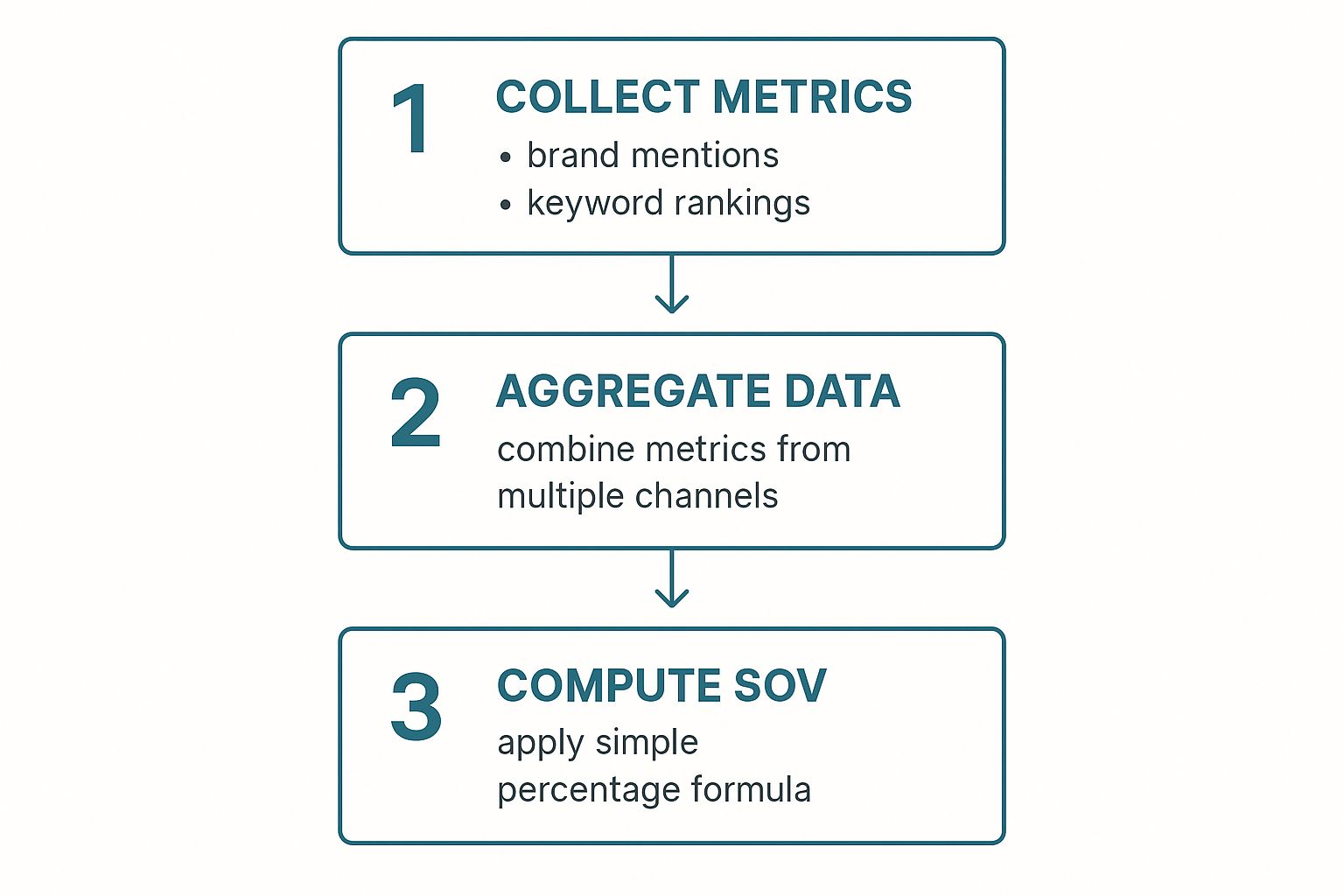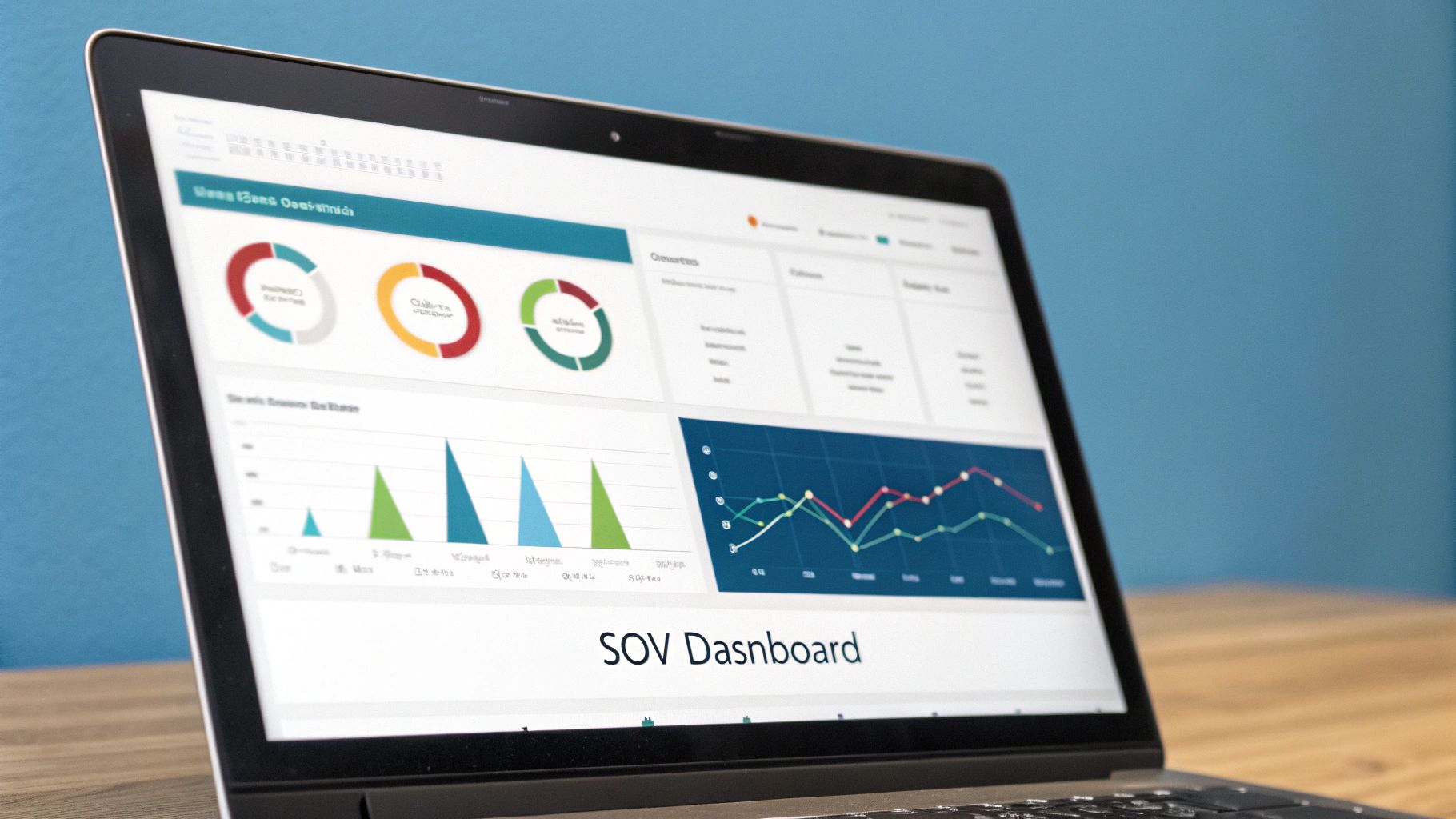
Forget the textbook definitions. As a founder, think of "share of voice" as a simple measure of how loud your brand is in a very crowded room. A bigger share of voice means more people hear you, which leads to better brand awareness, more authority, and ultimately, a bigger slice of the market pie.
Understanding Share of Voice in Today's Market

As founders, we don't have time for fluff. Let's get practical. Picture the entire online world as one giant stadium packed with your ideal customers. Your share of voice tells you how well your message is cutting through the cheers, chants, and chatter from your rivals.
It wasn't always this complicated. Back in the day, SOV was a simple equation tied to ad spend. If you bought 20% of the TV ads in your industry, you had a 20% share of voice. Easy. But relying on that old model today is a recipe for getting left behind.
Modern customers are everywhere—they find brands on Google, ask for recommendations on Reddit, read reviews, and watch TikToks. Your brand’s voice needs to be in all those places, not just the ones you pay for.
At BillyBuzz, we see modern SOV as a measure of our total presence across every channel that matters. It’s not just about paid ads; it’s about what we earn through great content and real conversations.
This shift is fantastic news for growing businesses. It means you don't need a massive budget to be heard.
The Evolution of Share of Voice
The way we measure share of voice has changed dramatically. It's moved from a narrow focus on ad budgets to a much broader view of a brand's total visibility. This evolution is what gives smart, agile startups a fighting chance against established giants.
Here’s a quick look at how things have evolved:
| Metric | Traditional SOV (The Old Way) | Modern SOV (The Founder's Way) |
|---|---|---|
| Focus | Advertising spend only | All conversations and visibility |
| Channels | TV, Radio, Print Ads | Organic Search, Social Media, PR, PPC |
| Measurement | Gross Rating Points (GRPs) | Brand Mentions, Keyword Rankings, Impressions |
| Advantage | Favors big budgets | Favors speed, relevance, and community |
This new approach isn’t just a theory; it’s built on proven marketing principles. The "SOV rule" has been around for decades, and it shows a clear link between visibility and growth. The data suggests that for every 10% increase in SOV you achieve above your current market share, you can expect about a 0.5% boost in market share over time.
Of course, you can't increase your share of voice if you don't know where you stand. A solid competitor analysis for marketing is the essential first step. You need to know where your competitors are showing up and what they're saying before you can start to carve out more space for your own brand.
How We Calculate Share of Voice at BillyBuzz
Theory is nice, but let's get down to how this actually works. As founders, we need a simple, repeatable process that gives us hard numbers, not just a vague "gut feeling." Here at BillyBuzz, we’ve ditched the overly complicated models for a straightforward approach that any startup can use.
The goal isn't to get lost tracking every metric imaginable. It’s about focusing on the channels where the real conversations about our industry are happening. For us, that means zeroing in on organic search visibility and social media mentions, specifically on Reddit. These two give us a powerful, combined view of our brand's health and reach.
And you don't need a massive, expensive software suite to do this. We rely on a couple of key tools. For everything search-related, we use Ahrefs to track our keyword rankings. For social listening, we use our own tool, BillyBuzz, combined with a tool like Brand24 for broader social monitoring.
The BillyBuzz SOV Formula
The calculation itself is incredibly simple, and that's by design. We apply the same basic formula to each channel to keep our numbers consistent and easy to compare.
Our SOV Formula: (Your Brand Metric / Total Market Metric) x 100 = Your Share of Voice %
So, what does that look like in practice? Let's say we get 200 brand mentions on social media in a month. If the total conversation—that's us plus our top three competitors—adds up to 1,000 mentions, our social SOV is 20%. We run the exact same calculation for our organic search traffic based on a core set of keywords.
This process gives us a clear percentage that we can track month over month. The trick is to define your "total market" consistently. We find that focusing on our three closest competitors keeps the data clean, relevant, and actionable.
This infographic really simplifies our three-step process for figuring out our share of voice.

It's just a simple workflow to make sure we’re consistently gathering the right data to calculate our standing in the market.
Tracking What Truly Matters
The whole idea of share of voice has changed so much. It used to be almost entirely about ad spend, but today it includes everything from online mentions and hashtags to customer reviews. A perfect example is Amazon, which recently captured 25% of all e-commerce-related organic traffic in the U.S. That's a massive SOV built on search visibility, not just ads. You can dig into more data on how leading brands dominate search results to see just how powerful this is.
Our process at BillyBuzz is built to capture this modern reality. We specifically track:
- Organic Search Visibility: We use Ahrefs to monitor our rank for about 50 high-intent keywords versus our competitors for those same terms.
- Social Conversation Volume: This is a straightforward count of all direct mentions of "BillyBuzz" versus our competitors' names across platforms like Reddit and X.
- Problem-Based Keywords: We listen in on conversations around key customer pain points (like "how to find customers on Reddit") to see who is leading the discussion and seen as the expert.
By pulling these specific data points together, we get a clear, multi-channel view of our share of voice. This isn’t some academic exercise. It’s a vital health metric that directly informs our content strategy, product messaging, and how we position ourselves against the competition.
Setting Up Your SOV Monitoring Dashboard

Alright, enough theory. Let's build a simple, effective system to monitor your share of voice. The good news? You don't need a massive budget. This is exactly how we started at BillyBuzz—with a lean setup that delivered actionable data from day one.
The whole point is to stop guessing and start making decisions based on real numbers. We’ll build this using free and low-cost tools that any founder can get a handle on.
The foundation is simple automation. We use Google Alerts as our free, 24/7 listening post for broad web mentions.
Our Exact Google Alert Rules
To cut through the noise, your alert rules have to be specific. Here are the exact queries we have running right now to monitor our brand, competitors, and key conversations:
- Brand Monitoring:
"BillyBuzz"- Always use quotes for an exact match. - Competitor Tracking:
"Competitor A" OR "Competitor B"- This groups rivals into a single alert, making it easy to see what they're up to. - Problem-Aware Keywords:
"how to find customers on reddit"- Our secret weapon. This tracks conversations where people are describing a problem we can solve, even if they've never heard of us. - Versus Keywords:
"BillyBuzz vs Competitor A"- A high-intent signal flagging when potential customers are weighing their options.
We have these alerts feed directly into a dedicated Slack channel. This way, the whole team sees important mentions in real-time, allowing us to jump on opportunities immediately.
Setting Up Social Listening in BillyBuzz
Google is just one piece. We use social listening to keep an eye on conversations on platforms like Reddit. Inside our own tool, BillyBuzz, we have keyword monitors running in specific subreddits where our ideal customers hang out, like r/startups, r/saas, and r/growmybusiness.
Our keyword setup has a few layers:
- Direct Mentions: We track "BillyBuzz" and common misspellings.
- Competitor Mentions: We watch our top three competitors to see where they're winning and where they're dropping the ball.
- Pain Point Keywords: We listen for phrases like “struggling with lead gen” or “can’t find early users.” These are buying signals.
We use filters to improve signal quality. For example, when tracking a common phrase like "customer acquisition," we use a negative filter
-courseto remove posts from people selling courses and focus on founders asking for help.
Putting all this data together doesn’t have to be complicated. We started with a basic Google Sheet, manually updating our mention counts weekly. For a deeper dive, check out our post on creating custom dashboards for social media monitoring. It’s all about building a system that gives you clarity without creating more work.
Our Playbook for Increasing Your Share of Voice
Knowing your share of voice is one thing. Actually growing it is different. This is our founder-to-founder playbook. I'm pulling back the curtain on the exact, battle-tested strategies we use inside BillyBuzz to make our voice heard.
We believe in punching above our weight. That means finding where high-value conversations are already happening and showing up in a way that’s genuinely helpful. Our entire strategy is built on surgical precision, not a massive budget. We pour our energy into three core areas: targeted Reddit engagement, creating category-defining content, and getting our story told on niche podcasts.
Our Secret Weapon: Reddit Engagement
Reddit is where our ideal customers—other startup founders—go when they're stuck. Showing up there to help is non-negotiable for growing our share of voice. Our approach is built on providing real value first.
- The Action: We use BillyBuzz to monitor r/startups, r/SaaS, and r/growmybusiness. We’ve set up alerts for keywords like “find customers,” “early users,” and “user acquisition struggles.”
- The Tool: BillyBuzz, of course. It pings us on Slack the moment a relevant conversation starts.
- The Result: Consistently being one of the first to offer useful advice drove over 40% of our inbound demo requests last quarter alone.
We never just drop a link. Our go-to response template is:
- Empathize: "I totally get how tough it is to find those first users."
- Give Actionable Advice: "Here’s a 3-step process we used that worked..." (Provide real steps, no fluff).
- Mention Tool (If relevant): "We built a tool to automate the monitoring part of this, but the manual process above is the best place to start."
Our Strategy: Category-Defining Content
To win at search, you can't publish another generic "Top 10" list. Our goal is to create the definitive resource for very specific, high-intent problems our customers face.
- The Action: We knew getting noticed is a huge struggle for new founders. So, we created the most comprehensive guide we could on that exact topic. You can see it in action in our article on the top 5 strategies to boost your startup's visibility online. It's a deep dive into frameworks that actually work.
- The Tool: We use Ahrefs to hunt for keywords with solid traffic potential but low competition. We focus on long-tail phrases that signal a specific need.
- The Result: That single article now ranks in the top three for several key search terms, driving a steady stream of high-quality traffic to our site every month.
Our Amplifier: Niche Podcast Outreach
Finally, we go where our audience is listening. Getting featured on a small, hyper-targeted podcast can have a massive impact on your share of voice within a specific community.
- The Action: We built a curated list of 25 podcasts focusing on early-stage startups with audiences under 10,000 listeners. We reach out with a hyper-personalized pitch, offering to share our story about finding our first 100 customers on Reddit.
- The Tool: No fancy software here, just a simple spreadsheet. The real work is listening to at least one episode of each podcast to make sure our outreach is genuine.
- The Result: This simple strategy has landed us on seven different podcasts this year, putting the BillyBuzz story directly in the ears of thousands of potential customers.
BillyBuzz SOV Growth Tactics
To make it even clearer, here’s a quick summary of how we tie specific tactics and tools to our goal of increasing Share of Voice.
| Tactic | Channel | Tool We Use | Key Metric |
|---|---|---|---|
| Value-First Engagement | Reddit, Niche Forums | BillyBuzz (for alerts) | Inbound Demo Requests |
| Problem-Focused Content | Organic Search (SEO) | Ahrefs (for research) | Top 3 Keyword Rankings |
| Expert Guest Appearances | Podcasts | Simple Spreadsheet | Number of Features |
| Community Q&A | Quora, Indie Hackers | Manual Monitoring | Brand Mentions |
These are the concrete actions we take every week. By combining automated monitoring with genuine outreach, we ensure our voice is not only present but respected in the conversations that matter most.
Common Share of Voice Mistakes to Avoid

We've made plenty of mistakes figuring this out, so you don’t have to. It’s easy to get bogged down in data or chase signals that don't matter. Steer clear of these common traps to stay focused on what really drives growth.
Mistake #1: Only Tracking Your Brand Name
One of the biggest missteps is focusing solely on your brand name. The real gold is in the problem-aware keywords your customers use long before they know you exist.
For instance, we track phrases like "how to find customers on Reddit" with the same intensity we track our own name. This shows us who is dominating the conversation at the exact moment potential customers are looking for solutions. It gives us a much more accurate picture of the competitive landscape.
Mistake #2: Ignoring Everyone Else's Noise
Your numbers mean nothing without context. If you’re celebrating 500 brand mentions this month but have no idea that your main rival just pulled in 2,000, you’re operating with a massive blind spot.
Our simple rule at BillyBuzz: every metric we track for ourselves, we track for our top three competitors. This creates a real-time benchmark that immediately tells us if we're gaining ground or falling behind.
You can't understand your own voice until you understand the noise around it. Consistently benchmarking against your competition turns SOV from a vanity metric into a strategic weapon.
This comparative view reveals true market dynamics and helps you spot weaknesses in your competitors' strategies that you can turn into opportunities.
Mistake #3: Chasing Volume Over Quality
Finally, don't fall into the trap of chasing volume. A high mention count is useless if the conversations are low-quality or irrelevant. Ten mentions in a highly-focused subreddit like r/startups are infinitely more valuable than 100 random mentions on X.
To counter this, we assign a qualitative score to our alerts:
- High Quality: A detailed post where someone is asking for a solution we provide.
- Medium Quality: A passing mention of a competitor in a relevant thread.
- Low Quality: A simple brand name drop with zero context.
This system ensures we prioritize our time and engage where it actually matters. Focusing on the quality of the conversation—not just the quantity of mentions—is the secret to turning your share of voice into actual customers.
Common Questions We Hear About Share of Voice
You’ve got questions, we’ve got answers. Here are a few of the most common things founders ask us about getting a handle on their share of voice.
How Often Should I Be Checking My SOV?
It depends on how fast your industry moves. If you're in a rapidly changing space, check in monthly. This keeps you on top of new trends and competitor moves.
For industries that move at a more measured pace, a quarterly check-in is probably sufficient. It's enough to see real changes without overreacting to tiny blips. The most important thing is to be consistent.
Is It a Lost Cause for a Startup to Compete with Big Players on SOV?
Not at all. This is where startups have a serious edge. You can't out-spend a massive corporation on paid ads, but you can definitely out-maneuver them.
The key is to be surgical. Dominate niche conversations on platforms like Reddit or become the go-to expert for super-specific, long-tail search terms. Find the channels the big guys overlook or consider "too small" to bother with—that's your battlefield.
Your superpower isn't a massive budget; it's your agility and authenticity. You can jump into real-time conversations, answer questions directly, and build a genuine community. Large corporations are often too slow for that. This is how you win a meaningful share of voice where it truly counts.
What's the Difference Between Share of Voice and Market Share?
This is an important one. Think of it like this: share of voice is a leading indicator, while market share is a lagging one.
SOV measures how much of the conversation your brand owns right now—social media mentions, press hits, and search engine visibility. Market share measures past performance—how much you sold as a percentage of the total market. Growing your share of voice is about building visibility and influence today to drive sales tomorrow.
Ready to stop guessing where your customers are and start dominating the conversations that matter? BillyBuzz helps you monitor Reddit, pinpoint high-intent discussions, and engage with potential customers before the competition even knows they're looking. Start finding your customers today.
